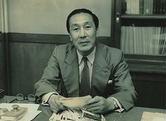
Asai Kazuhiko Ph.D. was the founder of Asai Germanium Research Institute and the creator of Asaigermanium. In the post-war turmoil, he has a firm belief and passion and has contributed greatly to Japan’s coal industry and scientific progress.
Here is the history of Kazuhiko Asai.
| 1908 | He was born on March 30 in Northeast China. He returned to Japan at the age of 10 and lived in Tokyo. |
| 1932 | He graduated from the Faculty of Law at Tokyo Imperial University (currently the University of Tokyo). He struggled to become a diplomat and passed the diplomat exam. |
| 1934 | Joined Okura group in spring. Sent to Berlin as a representative in Germany from th Commercial Department. |
| 1936 | In November, he married Erika Hoelter Hof, his secretary. In Berlin, there was a friend at the Japanese Embassy from the Tokyo University of Japan, but his mental was usatisfied. And therefore, he had a nervous breakdown. Then his German youth friend take him to the coalmine to reflesh, and he shocked to see people working hard against nature in the mine. Thus he dicided “I change my life and go on the road to coal research.” |
| 1937 | Entered from Charlottenburg University of Technology (now Berlin University of Technology) for coal research. |
| 1943 | Graduated from Charlottenburg University of Technology |
| 1945 | Just before the end of the war, he narrowly escaped death and returned to Japan. He established the Coal Research Institute for post-war reconstruction of Japan. Burden and his colleagues at Bell Laboratories in the United States invented transistors and diodes using germanium’s semiconductor properties. This invention was later awarded the Nobel Prize, and the world’s attention was drawn to the semiconductor properties of germanium. Asai knows that there is a lot of germanium in Japanese coal, and he is looking for a way to extract it from it. |
| 1952 | Succeeded in extracting germanium from coal dry distillation gas liquid. |
| 1953 | Succeeded in recovering germanium dioxide from coal dry distillation gas waste liquid. Refining ultra-high-purity polycrystalline germanium (ingot of germanium element) from germanium dioxide. Asai thought that germanium was taken in for some purpose while the original plant that had become coal lived, and decided to clarify the relationship between the plant and germanium. |
| 1955 | Measure the content of germanium in plants. I found that germanium is abundant in plants that have been said to be good for health since ancient times. |
| 1956 | In animal experiments using germanium dioxide fructose solution, the effect on radiation damage is confirmed, but it is found that it accumulates in bone marrow, spleen, kidney and the like. The conclusion is that it should be a highly safe organogermanium compound to be incorporated into living organisms. |
| 1957 | The government is awarded a purple emblem for contributing to the invention and the development of various new technologies. |
| 1962 | Obtained a doctorate in engineering from Kyoto University. |
| 1967 | Succeeded in synthesizing a water-soluble organogermanium compound for health care ahead of the rest of the world. At this time, he was bedridden due to many years of physical fatigue, mental stress, systemic multiple rheumatoid arthritis, gout, etc., but he took the first chemically synthesized organic germanium aqueous solution without a shred of suspicion. . He confirmed its efficacy and absence of toxicity and side effects on his own body. After 10 days he was well enough to walk. |
| 1968 | Established Asai Germanium Research Institute (Individual Research Laboratory). Made a presentation to the Chemical Society of Japan. |
| 1975 | In January, he was recommended as a full member of the New York Academy of Science. In September, his book “Germanium and I” was published. In his book “Germanium and I”, he advocated the “oxygen substitution theory” that germanium enriches oxygen in the body. He was also invited to the World Congress of Naturopathic Medicine held in France, where he gave a lecture on organic germanium, creating a sensation. Established Asai Germanium Laboratory Co., Ltd. |
| 1976 1977 |
Lectured at the Society of Natural Medicine held in West Germany (1976) and the United States (1977), attracting attention. |
| 1978 | Published the second book “Germanium Hymn (in Japanese)”. |
| 1979 | In June, the first germanium Study Group was held. Full-scale bioactivity research on organic germanium had begun with researchers from universities and research institutes nationwide. |
| 1981 | Published his third book “Germanium and My Life”. |
| 1982 | On October 22nd, he entrusted the researcher with the hope that “I want my germanium to be useful for people’s health” and ended his life. (Age 75) |

